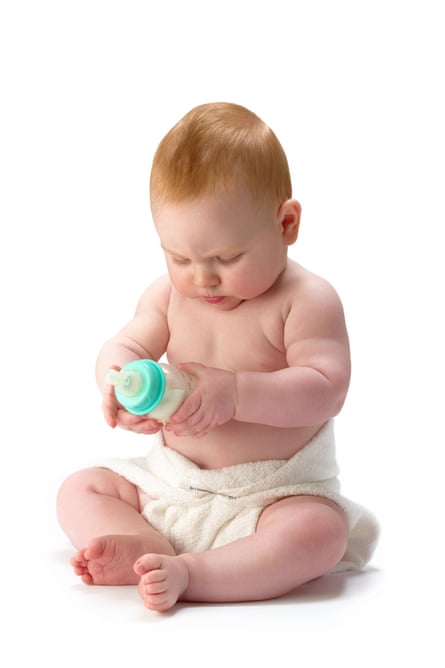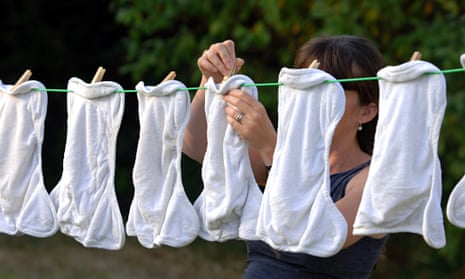The average baby gets through 4,000 disposable nappies by the time they’re potty-trained, costing families £400 a year and creating the equivalent of half a tonne of carbon dioxide.
Most toddlers are out of nappies – during the day, at least – by the time they’re two-and-a-half, by which point parents will have spent £1,000-plus on disposable nappies and upwards of £250 on the associated paraphernalia such as baby wipes, nappy bags and nappy bins.
These figures, from an Environment Agency study and consumer group Which?, may be enough to prompt parents to consider opting for reusable nappies instead. The reusable nappy information service Go Real claims parents can save at least £150 by switching away from disposables, with parents who go for the cheapest renewable brands able to save a lot more. And then there are the environmental benefits: experts claim disposable nappies take up to 500 years to break down.

Reusable nappies involve set-up costs, but while you can spend hundreds of pounds on kit, you don’t have to. Go Real reckons £80 will cover a pack of 20 of the cheapest reusable nappies and three waterproof wraps. Along with the cost of washing, it says the first year’s cost can be as low as £132.
By contrast, recent research by MoneySavingExpert found that using branded disposable nappies costs an average of £970 over 24 months, while own-brand nappies can cost £750.
But the decision to use disposables is not just about cost, says Rachel Burrows of UK parenting website Netmums. “Parents also factor in convenience, time and environmental ethics before deciding which works best for their family,” she says. “More parents are beginning to combine cloth and disposable, using disposables when their baby is out and cloth nappies at home where they are easier to clean.”
Burrows says that while cloth nappies are a lot more expensive to buy, they can save significant amounts of money if they are reused for later children. But parents must factor in laundry costs, which can range from a few pounds a week at home to £15 a week for a professional nappy laundering service.
Electricity and water bills also need to be taken into account. The Energy Saving Trust estimates that a 30C wash costs an average of 15p a cycle for water and 4p for electricity. As you turn up the heat, the cost of electricity rises: a 90C wash will cost 15p. Tumble drying costs a further 21p for each cycle.
However, many local councils offer incentives such as free trials, laundry services and cashback on reusable nappy purchases.
Guardian Money spoke to two mothers and discovered there were considerable savings to be had, even when mixing reuseables with disposables.
Michelle: £575.56 per child
Michelle Rankin, 36, is mother of three sons – Thane, six; Harris, four; and Lennox, three. They live in Bromley, Greater London.
The decision to use reusable nappies was an obvious choice, Rankin says. “From the very beginning I decided I didn’t want to be filling up landfill with nappies. I got the whole pack and actually ended up using them for all three children.”
The set-up cost was around £500 for 38 reusable nappies and parts, but Rankin is convinced that overall they were far cheaper than disposables, even though she used more expensive WaterWipes (£25 per calendar quarter). She also managed to recoup £80 when she resold the nappies online.
Rankin used 26 Motherease pre-folded popper-fastening nappies with an outer wrap and inner liner, which she bought in bulk for £15 each, including all three parts. She also bought 12 of the cheaper terry towelling nappies and rubber pants for around £10 each, plus £6 for a pack of five crocodile clips.
The liners and nappies were washed together twice a week on average, on a 70C wash. The nappies were then line-dried, apart from the terry ones which would be given 10 minutes in the tumble dryer to avoid them becoming “cardboard-like”.
Rankin says there were occasions when it was necessary to use disposable nappies.“The only time I used disposable nappies was at night, as reusables were not as nice on the skin all night. I also used disposables when we were travelling up to Scotland to see my mum.”
With her oldest child being out of nappies at 18 months and the other two at around two years, Rankin’s largest outlay was not on energy but on wipes and washing products.
Total estimated cost for three children from birth to potty trained (total of 5.5 years): £1,726.68, giving an average cost per child of £575.56.
Made up of: reusable nappies £436 (including £80 resale cost); disposable nappies £200.75; wipes £550; washing products £360.08 (based on two washes a week); electricity £85.80 (washing and tumble drying); water £94.05.
Sarah: £698.59 per child
Sarah*, 27, is mother of 15-month-old Theodore, from Kettering, Northamptonshire. A self-confessed “flitter” between reusable and disposable nappies, Sarah did not start using reusables until her son was six months old, and reverts to disposables in the winter or while on holiday. She uses Aldi’s Mamia nappies, which average 8p a nappy.

The pretty designs and comfortable fit of reusable nappies are the continued draw for Sarah now that she has ditched the disposables.
“My mum used cloth nappies with me and my two siblings. We had the terry ones with the pins. I thought I would give it a go, with the idea of saving money.”
Sarah signed up to a free cloth nappy trial with Kettering borough council, which meant she had a range of different brands to try before purchasing her own. She also received a £25 rebate from the council for buying reusable nappies.
Sarah started with gNappies (nappy covers that you use with biodegradable disposable inserts) during the day and Littlelamb cloth nappies at night, but soon found they did not suit her. They cost her £50. She briefly tried rewashable wipes but found them “more trouble than they are worth”, and now uses Pampers disposable wipes (£40 a year).
The gNappies include cloth pants, waterproof pouch and insert, all of which are machine-washable. Sarah spent around £140 on the gNappies pants, £28 on pouches and £30 on inserts. She also has four washable nappy bags for the wet and soiled parts, costing £16 altogether.
The pants and pouches are washed with normal loads, while Sarah washes the inserts about three times a week at 60C and once a month at 90C. These are then line-dried. She hopes to use reusable nappies when she has a second child, but thinks she will not start until he or she is around six months old, due to the quantity of nappies newborn babies go through, and the convenience of disposables.
Total estimated cost for one child from birth to potty trained (assuming potty trained at 30 months): £698.59.
Made up of: reusable nappies £223 (including council rebate); disposable nappies £167; wipes £100; washing products £145.99 (based on three washes a week); electricity £27.70; water £34.90. (Figures based on using disposables for three winter months a year and three holiday weeks a year, plus disposables until six months old.)
* Did not wish her surname to be published

Comments (…)
Sign in or create your Guardian account to join the discussion